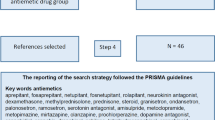Abstract
Goal of work
The objectives of this prospective observational study were to estimate the frequency of patients who reported an impact of chemotherapy-induced nausea and vomiting (CINV) on their daily life and to evaluate the determinants of such an impact.
Materials and methods
Adult cancer patients at seven Italian oncology centers who were receiving cisplatin-containing regimens reported incidence and intensity of CINV for eight consecutive days in a diary and completed a Functional Living Index for Emesis (FLIE) questionnaire.
Main results
Overall, 34% of patients reported vomiting and 62% reported nausea after chemotherapy. On days 1 to 5 after receiving chemotherapy, 67% of patients who had at least one emetic episode and 77% of those who suffered from at least mild nausea experienced an impact on their daily activities as measured on the FLIE questionnaire. More than 90% of all patients with both acute and delayed nausea or vomiting reported an impact on their daily life. Both acute and delayed vomiting contributed in similar measure to impact daily life; however, the importance of delayed nausea was greater than that of acute nausea.
Conclusions
Despite antiemetic prophylaxis, CINV is still prevalent and often impacts the daily life of patients in Italy, especially in the delayed phase. The duration more than the severity seems to be responsible for the impact of CINV on the patients’ daily lives.
Similar content being viewed by others
References
Aapro MS, Molassiotis A, Olver I (2005) Anticipatory nausea and vomiting. Support Care Cancer 13:117–121
Antiemetic Subcommittee of the Multinational Association of Supportive Care in Cancer (MASCC) (1998) Prevention of chemotherapy- and radiotherapy-induced emesis: results of Perugia Consensus Conference. Ann Oncol 9:811–819
Ballatori E (2001) Unsolved problems in evaluating the quality of life of cancer patients. Ann Oncol 12(Suppl 3):S11–S13
Ballatori E, Roila F (2003) Impact of nausea and vomiting on quality of life in cancer patients during chemotherapy. Health Qual Life Outcomes 1:46–58
de Boer-Dennert M, de Wit R, Schmitz PI et al (1997) Patient perceptions of the side-effects of chemotherapy: the influence of 5HT3 antagonists. Br J Cancer 76:1055–1061
Fabi A, Barduagni M, Lauro S et al (2003) Is delayed chemotherapy-induced emesis well managed in oncological clinical practice? An observational study. Support Care Cancer 11:156–161
Glaus A, Knipping C, Morant R et al (2004) Chemotherapy-induced nausea and vomiting in routine practice: a European perspective. Support Care Cancer 12:708–715
Gralla RJ, Osoba D, Kris MG et al (1999) Recommendations for the use of antiemetics: evidence-based, clinical practice guidelines. American Society of Clinical Oncology. J Clin Oncol 17:2971–2994
Griffin AM, Butow PN, Coates AS et al (1996) On the receiving end. V: patient perceptions of the side effects of cancer chemotherapy in 1993. Ann Oncol 7:189–195
Grunberg SM, Deuson RR, Mavros P et al (2004) Incidence of chemotherapy-induced nausea and emesis after modern antiemetics. Cancer 100:2261–2268
Grunberg SM, Osoba D, Hesketh PJ et al (2005) Evaluation of new antiemetic agents and definition of antineoplastic agent emetogenicity—an update. Support Care Cancer 13:80–84
Italian Group for Evaluation of Outcomes in Oncology (IGEO) (1999) Patient compliance with quality of life questionnaires. Tumori 85:92–95
Kris MG, Hesketh PJ, Herrstedt J et al (2005) Consensus proposals for the prevention of acute and delayed vomiting and nausea following high-emetic-risk chemotherapy. Support Care Cancer 13:85–96
Lindley CM, Hirsch JD, O’Neill CV et al (1992) Quality of life consequences of chemotherapy-induced emesis. Qual Life Res 1:331–340
Martin AR, Pearson JD, Cai B et al (2003) Assessing the impact of chemotherapy-induced nausea and vomiting on patients’ daily lives: a modified version of the Functional Living Index—Emesis (FLIE) with 5-day recall. Support Care Cancer 11:522–527
Osoba D, Zee B, Warr D et al (1997) Effect of postchemotherapy nausea and vomiting on health-related quality of life. The Quality of Life and Symptom Control Committees of the National Cancer Institute of Canada Clinical Trials Group. Support Care Cancer 5:307–313
Roila F, Donati D, Tamberi S et al (2002) Delayed emesis: incidence, pattern, prognostic factors and optimal treatment. Support Care Cancer 10:88–95
The Antiemetic Subcommittee of the Multinational Association of Supportive Care in Cancer (MASCC) (2006) Prevention of chemotherapy- and radiotherapy-induced emesis: results of the 2004 Perugia International Antiemetic Consensus Conference. Ann Oncol 17:20–28
The Italian Group For Antiemetic Research (1992) Ondansetron + dexamethasone vs metoclopramide + dexamethasone + diphenhydramine in prevention of cisplatin-induced emesis. Lancet 340:96–99
The Italian Group for Antiemetic Research (1995) Dexamethasone, granisetron, or both for the prevention of nausea and vomiting during chemotherapy for cancer. N Engl J Med 332:1–5
The Italian Group of Antiemetic Research (1995) Ondansetron versus granisetron, both combined with dexamethasone, in the prevention of cisplatin-induced emesis. Ann Oncol 6:805–810
The Italian Group for Antiemetic Research (1997) Ondansetron versus metoclopramide, both combined with dexamethasone, in the prevention of cisplatin-induced delayed emesis. J Clin Oncol 15:124–130
The Italian Group for Antiemetic Research (2000) Dexamethasone alone or in combination with ondansetron for the prevention of delayed nausea and vomiting induced by chemotherapy. N Engl J Med 342:1554–1559
Uyl-de Groot CA, Wait S, Buijt I (2000) Economics and health-related quality of life in antiemetic therapy: recommendations for trial design. Eur J Cancer 36:1522–1535
Acknowledgments
This study was funded by Merck and Company, Incorporated, Whitehouse Station, NJ, USA. Writing assistance was provided by Elizabeth V. Hillyer, DVM, ELS, with support from Merck and Company, Incorporated.
Author information
Authors and Affiliations
Corresponding author
Rights and permissions
About this article
Cite this article
Ballatori, E., Roila, F., Ruggeri, B. et al. The impact of chemotherapy-induced nausea and vomiting on health-related quality of life. Support Care Cancer 15, 179–185 (2007). https://doi.org/10.1007/s00520-006-0109-7
Received:
Accepted:
Published:
Issue Date:
DOI: https://doi.org/10.1007/s00520-006-0109-7




